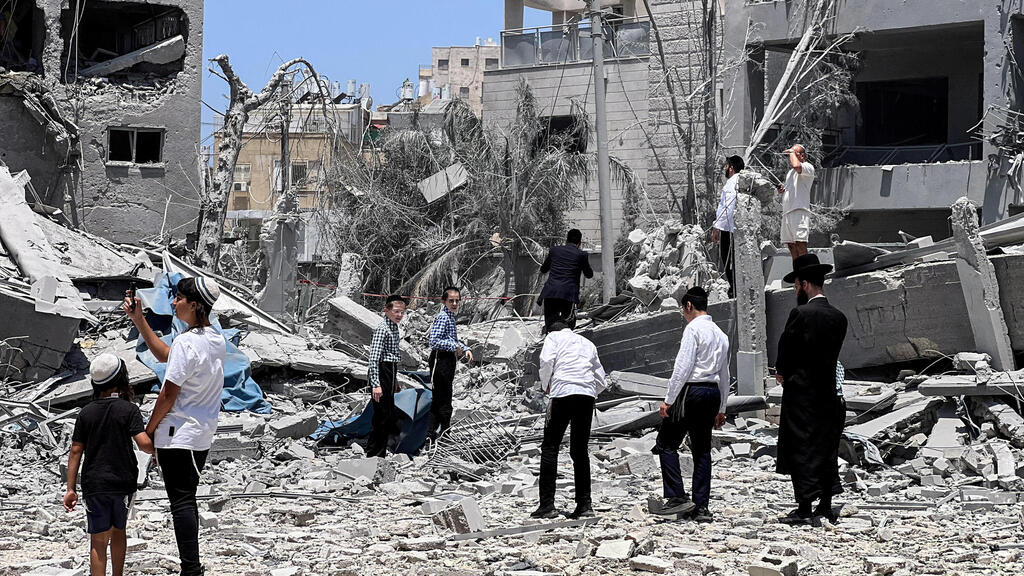3 View gallery


Buildings destroyed in Bnei Brak in an Iranian missiles trike on Monday
(Photo: Miro Maman/ Reuters)
Iranian missiles launched against Israel
“Iran has established its missile and UAV arsenal in recent decades because of the understanding that it cannot compete with Israel’s air force,” said Boaz Shapira, a researcher at the Alma Research and Education Center, a think tank focused on Israel’s northern security. “They have very good capabilities and a wide range of missiles with varying ranges and abilities.” The Israeli military has not disclosed what types of missiles Iran has used in the attacks.
Before Israel’s assault, the Islamic Republic was believed to possess roughly 3,000 ballistic missiles. The Israeli military claims that a significant portion of that stockpile has now been destroyed.
Shapira believes Iran has likely used Imad and Ghader missiles, and possibly Fatah-1 or Kheibar types. Some reports suggest that the Haj Qasem missile was used in the strike on a central Israeli high-rise that caused heavy casualties. Named for Islamic Revolutionary Guard Corps (IRGC) commander Qasem Soleimani, who was killed by the US in 2020, the hypersonic missile has a 1,400-kilometer range, a 500-kilogram payload, enhanced guidance systems, and high accuracy.
They are deliberately targeting population centers
“These are very accurate missiles. The Iranians know exactly where they are aiming and exactly where they do not want to hit,” said Dr. Yehoshua Kalisky, a senior researcher at the Institute for National Security Studies. “They are deliberately targeting population centers.”
Kalisky believes Iran is holding back its most sophisticated missiles for future use, possibly waiting for the conflict to escalate further. It has not yet deployed its Khorramshahr missiles, which can carry up to 1,800 kilograms of explosives over 3,000 kilometers. “They are attacking in a staged way,” he said.
Hossein Kermanpour, a spokesman for Iran’s Health Ministry, stated on his X account that more than 1,400 people have been killed or hospitalized since Israel’s assault began on Friday. He claimed over 90% of the casualties were civilians, contradicting Israel’s assertions that it is only targeting military sites.
Little official information exists about Israel’s missile stockpile. Analysts estimate that Israel possesses hundreds of short- and medium-range ballistic and cruise missiles, dozens of long-range ballistic missiles, and thousands of precision-guided rockets and other munitions. While Israel has never acknowledged possessing nuclear weapons, it is widely believed to have them.
Israel is thought to maintain both a numerical and technological edge over Iran. In the current campaign, the Air Force has led most operations, with the Navy also playing a role.
Whether Israel has used its Jericho long-range surface-to-surface missiles remains unknown. The existence and status of the Jericho system are inferred from observed test launches and international tracking data, though never officially confirmed.
Israel also uses drones and UAVs in combat and is reportedly deploying them extensively in this conflict.
The country operates a five-layered air defense network. These include Iron Dome, which counters short-range rockets; David’s Sling, designed for medium- and long-range rockets and tactical ballistic missiles; the Patriot system; and Arrow 2 and 3, which intercept high-altitude ballistic missiles, including during spaceflight.
On Monday, the IRGC claimed it had developed a new tactic using decoy targets to overwhelm Israeli defenses, allowing real missiles to bypass detection.
“There are a few methods that could confuse defense systems,” said Kalisky. “On some of Iran’s missiles, including the Haj Qasem, the thrust vectoring of a missile can slightly change the trajectory mid-flight several times.”
“Another method might be to fire several decoys that force defense systems into trying to intercept them as well,” he said.
According to Kalisky, Israel’s Arrow 3 system is specifically designed to distinguish real threats from decoys using advanced sensors.
The fact that Israel currently maintains an almost 90% success rate is no less than a miracle
“But no defense is 100% hermetic,” he added, referencing Iranian missiles that recently struck civilian buildings. Kalisky echoed calls from Israeli officials and commanders urging civilians to strictly follow Home Front Command safety guidelines. “It is important to remember that without our air defense systems, Israel would be facing major destruction.”
“The challenges to the defense systems are immense—from the quantity of threats to the density of the barrages, the availability of interceptors and the ability to track targets,” said Shapira. “The fact that Israel currently maintains an almost 90% success rate is no less than a miracle.”
Israel has enhanced its drone and UAV defense capabilities throughout its war with Hamas, which began in October 2023, as well as its simultaneous conflicts with Hezbollah in Lebanon and other regional fronts.
On Sunday alone, dozens of Iranian UAVs were launched throughout the day. All were intercepted by Israeli forces.
“Israel’s detection capabilities now span Iran, Iraq, and Syria. The threat is detected long before it reaches Israel,” said Shapira. “This gives plenty of response time.”
Israel has vowed to continue operations inside Iran until it neutralizes Tehran’s nuclear program and its existing ballistic missile threat—two areas where Iran is believed to have made recent progress. Israel defines both as existential threats.
“There is no way to completely destroy all of Iran’s missiles,” said Kalisky. “They are easily concealable weapons, highly transportable, and easy to operate and launch.”





